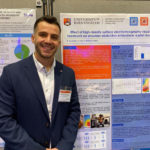
Astronauts are at increased risk of intervertebral disc (IVD) herniation when they return to Earth, and this may occur in both the neck and back regions. The risk of IVD herniation in the neck region is over 21 times more likely in astronauts than in the general population. Several factors could potentially explain this increased risk of IVD herniation following space flight, however, the evidence is still scarce.
Our CPR Spine team members focus on the measurement of neck muscle activity together with measures of functional performance of the neck muscles both prior to and after spaceflight using state-of-the-art methodologies (e.g., high-density electromyography). The knowledge gained from this project will provide critical insight into the factors contributing to the higher risk of developing IVD herniation post space flight.
Such knowledge can be used to facilitate the development of appropriate exercise programmes to decrease the risk of IVD herniation in astronauts (e.g., neck exercises during spaceflight). Moreover, such knowledge will further our understanding of changes in muscle function associated with IVD herniation which will be transferable to the general population.
The following figure illustrates part of the data collected from an astronaut at Johnson Space Centre, NASA facilities in Houston, Texas:

